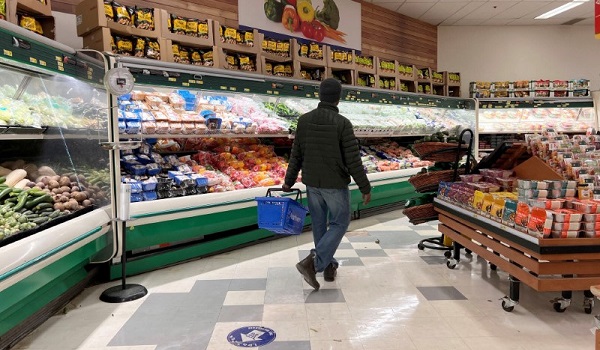Canadian grocers scrambling to find backups to U.S. goods before threatened U.S. tariffs hit
The head of a small Toronto-area grocery chain summoned his buyers to an emergency meeting at 7 a.m. on Monday.
With a trade war looming, Giancarlo Trimarchi, president of Vince’s Market, wanted to know where he was vulnerable to tariffs on American goods.
He ordered each of his buyers to conduct a full country-of-origin analysis of their respective sections — bakery, produce, deli, dry goods — and report back with a list of high-risk items.
By the end of the week, the reports were in: bottled salad dressing could be trouble, he was told. Some rice, too. And if things really escalated, lettuce could be a problem.
“We’re nervous, of course,” Trimarchi said.
While U.S. President Donald Trump agreed to a 30-day reprieve from his threatened 25-per-cent tariffs on Canadian goods earlier this week, grocers and food manufacturers in Canada are still scrambling to line up backups to American goods, in case negotiations break down.
Per Bank, CEO of Loblaw — Canada’s largest grocery chain — said earlier this week that the company is “doubling down” on Canadian-made products.
At Vince’s Market, a chain of four stores north of Toronto, about 75 per cent of salad dressing sold in stores are American-made, and Trimarchi worried that a tariff-related price hike of even just one or two dollars could be enough to tank sales.
He said his message to his team of buyers was, “you’ve got to go take a look at the salad dressing category with fresh eyes.”
The hope is they find Canadian vendors they missed the first time around.
“We’re going to take, I imagine, a bunch of vendor meetings,” he said. “Everyone’s starting to call now. Anyone that has a Canadian-made product, they’re starting to get out there.”
Before this week’s temporary truce, Canada had already released an initial list of U.S. products that would be subject to retaliatory tariffs in the event of trade war. Ottawa said it was also consulting on a broader list of $155 billion in tariffs against the U.S.
Food executives and academics said it looked like the government had carefully selected the food on the initial list in an effort to avoid major price shocks for Canadian consumers at the grocery store. In most cases, if a tariff raised prices for an American product on the shelf, there’d be a cheaper alternative that was made in Canada or overseas.
American pasta was on the list, for example, but most stores have a wide selection of Italian and Canadian made options. As for some American cheese, eggs and poultry on the list, those items are already hard to find in Canadian grocery stores due to federal policies that shelter domestic farmers from foreign competition.
But some are afraid that subsequent rounds of retaliatory tariffs will include food that is harder to find non-American alternatives for, like lettuce. The Bank of Canada has also warned that a weaker exchange rate for the Canadian dollar could also make all imports more expensive — not just American ones.
This week, produce importers at the Ontario Food Terminal weren’t concerned with Canada’s initial list of retaliatory tariffs, since they could easily find alternative sources. For example, they were confident that if citrus from California was subject to tariffs, they could just switch to ordering fruit from Morocco or Spain instead. But it would be a lot trickier if Canada started adding vegetables to the list.
“We’re just sort of waiting for the vegetable axe to fall,” Vince Bisogno, senior manager at Burnac Produce, said in an interview earlier this week.
That “vegetable axe” has been hanging over the Canadian food system long before the current dispute with the Trump administration. As a country with a narrow growing season, Canada depends deeply on California for much of its supply of fruits and vegetables through the winter.
But a rash of issues related to climate change in California, including drought and disease, have made that powerhouse growing region less reliable in recent years.
“We need to just forget about California lettuce,” said Lenore Newman, director of the Food and Agriculture Institute at the University of the Fraser Valley. “We just need to forget it exists.”
But California lettuce can be tough to quit. With oranges, you can afford to switch to another, far-off country because the fruit will last a few weeks in a shipping container. Lettuce is more delicate. It would rot on a long voyage. But from California, it can be in Toronto stores within five days.
The reliance on California lettuce is one of the many ways the U.S. and Canadian food systems are almost impossibly tangled together, said Evan Fraser, director of the Arrell Food Institute at the University of Guelph.
Food production skips back and forth over the border, he said, to the point that blueberries grown in British Columbia are picked and shipped to Washington to be washed and packaged, then shipped back.
“Where we’re most vulnerable is fresh produce,” Fraser said.
The way to fix the problem, long term, is to use advancements in plant varieties and LED lighting to grow lettuce and other crops, including strawberries, indoors in Canada, even in winter.
Since the pandemic, a new generation of farming outfits have been slowly scaling up Canada’s ability to grow lettuce indoors, year-round. Rabba Fine Foods, a chain of 37 stores across the GTA, was one of several retailers meeting with indoor lettuce suppliers this week, as a backup for American-grown produce it currently sells in its stores, according to president Rick Rabba.
This week, retailers like Rabba were calling GoodLeaf Farms, a Canadian vertical farming operation that grows lettuce at three windowless facilities in Calgary, Montreal and Guelph.
“Yeah, lots of discussion, lots of calls from various retailers,” GoodLeaf CEO Andy O’Brien said on Friday.
With files from The Canadian Press
This article was first reported by The Star













